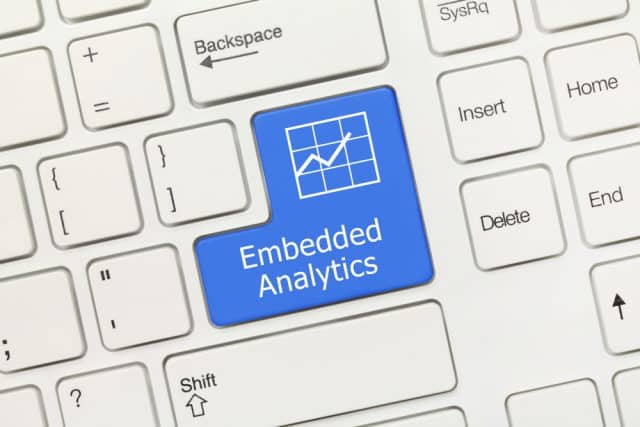You don't need tableau: How to integrate analytics into the apps you already have

In recent years, organizations have invested billions of dollars outfitting employees with traditional business intelligence (BI) tools. Yet, the vast majority of employees still have not bought into the trend. That's not because company BI and industry data underpinning those platforms aren't robust. It's because the analytics necessary to allow companies' knowledge workers to recognize shifting metrics, make timely business decisions and remain at the forefront at interpreting industry trends must be more intuitive and customizable than traditional platforms achieve.
Insight from nearly 2,000 knowledge workers compiled earlier this year by Hanover Research shows that virtually all of them spend time looking for information their BI platform doesn't provide. Three out of four said they would likely adopt a new analytics solution if it was embedded within an application. This reveals a disconnect between their desire to use data analytics in decision-making and the ability to draw upon intelligence tools at their disposal. To avoid such meandering on a one-size-fits-all pathway, instead, incorporate embedded analytics and seek deliberate functionality to achieve maximum value from BI.
Embed Analytics
The best analytics and user experiences (UX) outperform general BI platforms and can ensure making the most of any organization's intelligence. Modern capabilities of embedded analytics allow for creating interactive dashboards that any organization can rely upon to pull data, realize real-time analysis and achieve true insight.
There are numerous analytics options worth considering.
- Intuitive Dashboards: Dashboards must be customizable to reveal the BI that each analyst level requires. The intelligence must be relevant to boost decision-making yet not overwhelm the user's view or allow access or manipulation of purposefully restricted information. When considering visualizations, be sure to prioritize how their display will enhance outcomes.
- Reveal Invisible Intelligence: The analytics app collects data behind the scene and must present that intelligence compellingly; otherwise, decisions can suffer. Providing useful information requires adept app developers to understand the data being compiled for users and the motivators affecting users' decisions. Interactive dashboards can then present data that’s otherwise shrouded or simply overwhelming and furnish them in a highly visible fashion as actionable intelligence.
- Active User Profiles: Analytic apps that understand their users provide the most robust engagement. That means its target users will be populating their specific roles and responsibilities into the functionality and adding the profiles of analyst roles that may join the organization in the future. Whether seeking increased efficiencies or revenue, reductions in costs or overruns, or improvements in customer satisfaction or engagement, these and other characteristics that the user self-populates and -arranges will significantly improve the analytic intelligence they receive.
- Tandem Evolution: Data and the analytics generated by the BI must evolve as the organization matures. So upgrades and other changes should address the business needs of today and forecast what's over the horizon. By anticipating the speed of change in data and embedded analytics, robust apps enable analysts to complete their objectives with the benefit of compelling intelligence that continually suits their needs.
Cybersecurity is woven throughout BI platforms and embedded analytics whether the BI resides in the cloud, multi-cloud or even on-premise. As a result, recommendations on features, changes and updating, as already noted, require robust security and authentication measures that maintain productive UX, too.
Choose Variety
More functionality is desirable when faced with distilling and interpreting data. How data delivery works for one analyst or team may not align precisely with how others require their analytics to be presented. Different audiences can demand different deliverables even when they're working from the same script. For this reason, it's reasonable to seek variety.
- Data Visualization: Charts, graphs, gauges, heat and geographic maps and other dashboard features can be catalysts for monitoring performance, appraising circumstances and making decisions. These and other visualizations populate the most engaging dashboards.
- Robust Reports: Tabular displays of data, often grouped within categories and presented with dropdowns and filters to pull specific information, are BI staples.
- Mobile Marvel: Dashboard features that transition onto mobile devices should maintain their versatility, ensure accurate display of intelligence and retain functionality that includes touchscreen input.
- Liberally Linked: Hyperlinked visualizations and reports will allow users to navigate to different screens or other parts of the analytics app. They can also customize the screen for individual user sessions.
- Scheduling and Exporting: Dashboards and reports can be scheduled for delivery, pulled on-demand or even programmed for alerts or thresholds. Additionally, this intelligence can be exported for offline use and printing.
The UX created by modern consumer apps has conditioned everyday users to become even more savvy in their analytical workspace. Users expect information immediately available at their fingertips, and self-service functionality allows even non-traditional app users access to BI to make critical business decisions. So, to successfully offer a great UX and achieve productive results, have data analytics incorporated naturally into the app.
Better Analytics Makes Better Decisions
Analytics are essential for increasing the efficiency of informed decision-making. As influenced by the coronavirus pandemic, many industries and especially healthcare, manufacturing and financial services have had their historical, predictive indicators turned upside down. That’s making robust analytics even more necessary now and in the future.
Knowledge workers must be able to capture the information they need to drive business decisions and results. Standalone BI solutions are not serving these decision-makers successfully. Embedded analytics is the most effective solution as rapid innovation continues to shape today's business environment. They present engaging methods for users to interact with their BI, and pave the way for more informed and productive results.
Photo Credit: Artem Samokhvalov/Shutterstock

Charles Caldwell is the vice president of product management at Logi Analytics, which empowers the world's software teams with the most intuitive, developer-grade embedded analytics solutions. He has more than 20 years of experience in the analytics market, including more than 10 years of direct customer implementation experience. Charles writes and speaks extensively on analytics with an emphasis on in-app embedding, optimizing user experience, and using modern data sources.
